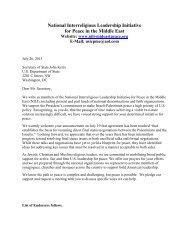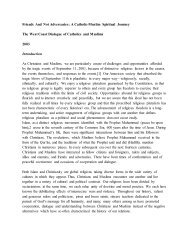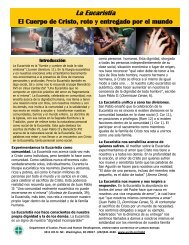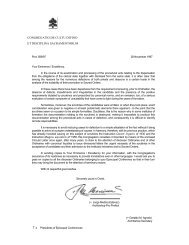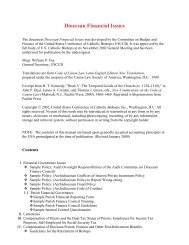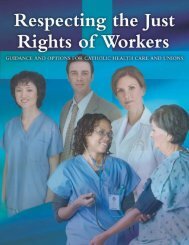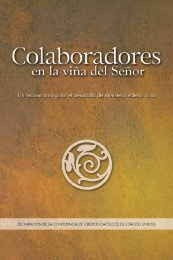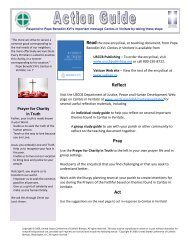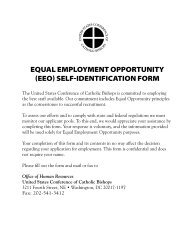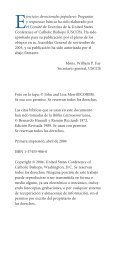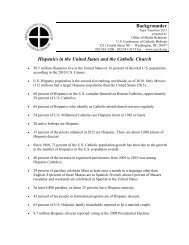Doctrinal Elements of a Curriculum Framework for the Development ...
Doctrinal Elements of a Curriculum Framework for the Development ...
Doctrinal Elements of a Curriculum Framework for the Development ...
- No tags were found...
Create successful ePaper yourself
Turn your PDF publications into a flip-book with our unique Google optimized e-Paper software.
4. The vine and branches (CCC, no. 787).5. The seed and <strong>the</strong> beginning <strong>of</strong> <strong>the</strong> Kingdom (CCC,nos. 541, 669, 764, 768).6. The family <strong>of</strong> God (CCC, nos. 791, 1655-1658,2204-2685).C. Images rooted in Scripture and developed in Tradition.1. The People <strong>of</strong> God (CCC, nos. 781-782).2. The way to salvation.3. Marian images (CCC, nos. 507, 773, 967, 972).4. The community <strong>of</strong> disciples.5. A pilgrim people.III. The Marks <strong>of</strong> <strong>the</strong> Church“The sole Church <strong>of</strong> Christ which in <strong>the</strong> Creed we pr<strong>of</strong>essto be one, holy, catholic, and apostolic . . . subsists in <strong>the</strong>Catholic Church” (CCC, no. 870).A. The Church is one (CCC, nos. 813-822).1. Unity is in Jesus Christ through <strong>the</strong> Holy Spirit; itis visible unity in <strong>the</strong> world.2. The Church is united in charity, in <strong>the</strong> pr<strong>of</strong>ession<strong>of</strong> one faith, in <strong>the</strong> common celebration <strong>of</strong> worshipand sacraments, and in Apostolic Succession(CCC, no. 815).3. Unity in diversity.a. Multiplicity <strong>of</strong> peoples, cultures, and liturgicaltraditions (CCC, nos. 814, 1202).b. Communion <strong>of</strong> twenty-one Eastern CatholicChurches and one Western Church, all inunion with <strong>the</strong> Pope.4. Wounds to unity.a. Heresies (note modern parallels).1) Early Church heresies: Gnosticism,Arianism, Nestorianism, Monophysitism,and Apollinarianism (CCC, nos. 464,466-467, 471).2) Protestant Re<strong>for</strong>mation: emphasized solascriptura (<strong>the</strong> Bible alone) and sola gratia(grace alone).3) New divisions—sects and cults.b. Schisms (<strong>the</strong> split between East and West).1) Following <strong>the</strong> Council <strong>of</strong> Ephesus in 431,those Churches which followed Nestoriusestablished separate Churches; laterreturned to union with Rome.2) Following <strong>the</strong> Council <strong>of</strong> Chalcedon in451, those who accepted <strong>the</strong> Monophysiteposition <strong>for</strong>med what are called <strong>the</strong>Oriental Orthodox Churches.3) Eastern Schism <strong>of</strong> 1054: <strong>the</strong> pope inRome and <strong>the</strong> bishop <strong>of</strong> Constantinopleexcommunicated each o<strong>the</strong>r, thusleading to <strong>the</strong> breach between <strong>the</strong>Roman Catholic Church and <strong>the</strong> EasternOrthodox Church.c. Apostasy.5. Ecumenism.a. Jesus’ prayer <strong>for</strong> unity <strong>of</strong> his disciples (Jn 17:11;CCC, no. 820).b. Vatican II documents.c. Ecumenical dialogues with OrthodoxChurches and Protestant ecclesial and faithcommunities emphasized common baptism<strong>of</strong> all Christians and common service to loveeven to <strong>the</strong> point <strong>of</strong> joint-martyrdom.d. The fullness <strong>of</strong> Christ’s Church subsists in <strong>the</strong>Catholic Church (LG, no. 8).6. Interreligious Dialogue.a. Judaism, which holds a unique place inrelation to <strong>the</strong> Catholic Church.b. Islam.c. O<strong>the</strong>r religions.B. The Church is holy (CCC, nos. 823-829).1. Holiness is from <strong>the</strong> all-holy God: all human beingsare called to live in holiness.2. Christ sanctifies <strong>the</strong> Church through <strong>the</strong> HolySpirit and grants <strong>the</strong> means <strong>of</strong> holiness to <strong>the</strong>Church.3. Church members must cooperate with God’s grace.a. Divine dimensions <strong>of</strong> <strong>the</strong> Church.b. Human dimensions <strong>of</strong> <strong>the</strong> Church.4. Church members sin, but <strong>the</strong> Church as Body <strong>of</strong>Christ is sinless.a. Church constantly fosters conversionand renewal.5. Mary, Mo<strong>the</strong>r <strong>of</strong> <strong>the</strong> Church and model <strong>of</strong> faith.a. The Annunciation and Mary’s “yes” to God.b. Mary’s perpetual virginity.c. The Immaculate Conception and <strong>the</strong>Assumption.6. Canonized saints: models <strong>of</strong> holiness.a. Their example encourages us.b. They intercede <strong>for</strong> us.16<strong>Doctrinal</strong> <strong>Elements</strong> <strong>of</strong> a <strong>Curriculum</strong> <strong>Framework</strong> <strong>for</strong> <strong>the</strong><strong>Development</strong> <strong>of</strong> Catechetical Materials <strong>for</strong> Young People <strong>of</strong> High School Age



